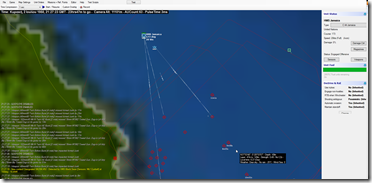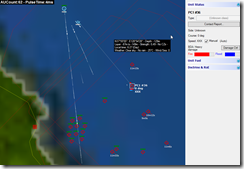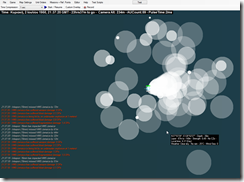Controlling the battle: Improved BDA and at-a-glance damage/fire/flooding stats
 By now we are well on the home stretch for Command’s v1 release so there isn’t really much new to mention (majority of work being on polishing, bug fixes, content, support material etc.). Occasionally though something significant gets added, and this is one of those cases.
By now we are well on the home stretch for Command’s v1 release so there isn’t really much new to mention (majority of work being on polishing, bug fixes, content, support material etc.). Occasionally though something significant gets added, and this is one of those cases.
One of our earliest beta feedback reports was as follows:
I’m playing the Battle of Chumonchin Chan and I really like it. Old school guns and torpedoes. One thing I’d like to see is some kind of visual feedback for damaged ships, friendly and enemy. I’m hitting enemy ships and land targets and I have very little feedback – even though they’re often in visual range, I can’t tell if they’re burning, sinking, or what. I see that I’m hitting them just fine (though the messages tend to fly by too fast to keep track of anything when more than one ship is engaging). It’d be helpful to have some feedback, either some way to indicate the target is burning or smoking or something. Maybe put it in the contact report?
Ditto for friendly ships. The HMS Black Swan got a little too close to a [NK] battery (and damn, they shoot like they’ve got a full fire control system!) and it was at 80% damage, but I had no idea what was affected. Almost everything was ‘damaged’ and the ship was on fire and flooding, but I didn’t get any real sense of what was going on or how bad things were. Were the fires under control? Was flooding being controlled? Was the ship actually sinking, listing, settling by the stern? Were the crew all casualties? Some more detail at some point would be helpful […]
Chumonchin Chan is one of the scenarios bundled with v1 and features a surface gunfight off the coast in the middle of the Korean conflict. With lots of ships and numerous coastal gun batteries in the fray, suffice to say things can get a little… intense. How much? Here is an extreme close-up of the cruiser Jamaica, maneuvering amidst water splashes from near-misses:
So we agree, in the middle of this chaos it would help to have an at-a-glance check of who has what sort of damage, friendlies and enemies alike.
So we went back to our existing DBA model and revamped it in greater detail. More importantly we added selective BDA ability to sensor checks so that a unit detected will not automatically have every damage detail known about it. Different sensor classes can reveal different information; for example IR sensors are great for detecting fire at long range but are not so effective at discerning structural damage or flooding. Passive sonars can reveal useful flood damage info on a precisely-identified contact but are worthless for fires. (Not surprisingly, the plain old Mk1 eyeball is an excellent all-round BDA sensor, though limited in range.)
In addition, we inserted extra visual cues in the map symbols and on the unit/contact status window that allow a quick overview of a unit’s damage status, with separate indicators for structural damage, fire and flooding.
Here’s a snapshot of the battle without the enhancements:
And here is the same situation with the new UI elements:
In the latter case we can tell right away, even without looking at the unit status window, that PC1 has heavy structural damage (short red bar above icon), severe fire in progress (red bar under icon) and moderate-to-heavy flooding (blue bar). These indications are also reflected on the unit status window, but by having them on-map we can display them for multiple units concurrently.
(Fire & flood damage intensity is important for a number of reasons. Increased severity of either type of damage progressively destroys the structural integrity of the damaged unit. In addition, at the highest fire level [conflagration] a unit may suffer magazine explosions and disintegrate immediately. Likewise, at the most severe flooding level a ship may capsize and sink immediately.)
Note that the damage estimates for non-friendly units are just that, estimates. Sometimes a unit will be more or less damaged than its estimates reflect (particularly if the BDA attempt was made at the fringes of the relevant sensor range), or may have stronger or weather fire/flood levels. The BDA information is also current only for the time point at which it was collected, and may lose its validity over time. So BDA & recon missions (everything from U-2/SR-71/MiG-25R overflights to sub snoops to special forces teams camped outside an enemy base) are now actually critical.
And the march towards v1 continues.






